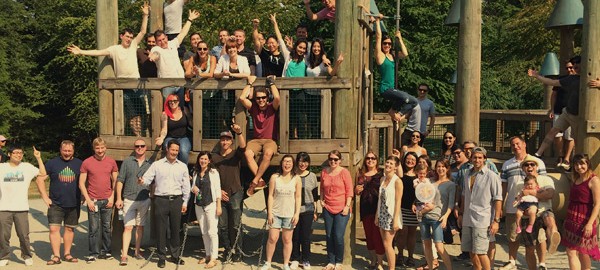 At Allocadia, we are going through the company culture journey. I have a board member who has always challenged me to think about how we build a company that people (team members, customers, partners, investors, vendors) want to be a part of. It was only when we grew to 60 people that I felt I understood just how important culture was.
At Allocadia, we are going through the company culture journey. I have a board member who has always challenged me to think about how we build a company that people (team members, customers, partners, investors, vendors) want to be a part of. It was only when we grew to 60 people that I felt I understood just how important culture was.
I had this moment when I thought, “Wait a minute, this is going in a direction we don’t want as a team!” The key questions quickly became: Where do we want our culture to go? What is culture? And should we (or could we) proactively build culture in an authentic, organic way? This started our official purposeful investment in culture.
Our culture journey has made me think of our CMO clients. I talk to a lot of CMOs who are also thinking about how they build a team and culture that people want to join. More than ever today, CMOs are focused on how they attract top talent, and then build a high-performance environment. The stakes are high today: Marketers are key drivers of growth and the customer experience. CMOs have to work on “the business of marketing” – ensuring they have the systems and processes, and a cultural environment, where their team members can excel.
So here’s how we started on this journey and what we’ve learned so far. For us, this is only the beginning. CMOs: You can also follow these steps to start building culture in your team (cascading down from the company culture and extending it to map to your team and what’s important to you, or, in the absence of a defined company culture, perhaps start creating your own!).
1. Get clear on your definition of culture.
We first tackled company culture by getting clear on what company culture even meant. There are hundreds of definitions of culture, but this is one that resonated with our team: “Culture is the organization’s immune system.” (That definition comes from this HBR article, where you can find a bunch of other definitions to get you started.) Many lunch conversations at Allocadia seem to be about immune systems and staying healthy! With healthy eating and exercise, you can keep the immune system in its best condition. Conversely, culture can be viewed as a form of protection: It prevents “wrong thinking” and “wrong people” from entering the organization in the first place. It’s a complex system, but it’s clear you need to maintain it to run in optimal condition. We also liked Airbnb’s definition of culture in their famous post, “Culture is simply a shared way of doing something with passion.”
2. Ask: What is our culture today?
After we defined what culture means, we asked our team to describe the Allocadia culture. We talked to the leadership team, team members, investors and partners. This is a great exercise, because it helps you understand where you are today — the foundation you’ll build on. For me personally, this exercise made me realize I wasn’t describing our culture consistently or thoughtfully, which meant I wasn’t doing the best I could in telling the story to attract people to Allocadia. We learned this was the case across our team. So this simple question started us on the path toward learning.

3. Start talking about culture as a team.
We engaged a leader in people and culture to guide us through the process with our team. With her help, our leadership team looked at our current culture and started a dialogue. She also facilitated company-wide feedback sessions, starting with a great exercise: She asked team members to bring in an object that represents the Allocadia culture to them. These objects got the discussion and learning started, and it was fun – it was a culture-building exercise in and of itself! People shared fun early stories or experiences with the team they may never have heard before. We talked about our current culture, the challenges and positives, and how we wanted to grow and change.
4. Share the feedback back with the team.
This was an important step in the process. Once you’ve collected feedback, you want to share themes back with the team. You don’t want to shy away from sharing the harder parts. We collected all the feedback into five key themes that we shared in one simple PowerPoint slide. For example: “We want to be more united and less divided into silos.” We shared what we’d heard and areas the team wanted to focus on. It was not yet the solutions and where we wanted the culture to be; we’d get to that in the next step!
5. Start to write down your core values and cultural elements.
At the end of the day, someone has to translate themes from the team and put them down on paper. One night over dinner, my twin sister co-founder and I did the first cut after a team meeting on culture. It was hard as at first – it didn’t feel like it was really Allocadia. We had our aha moment when we realized the concept of transformation – and butterflies – had been a core part of our culture from Day One. As a result, we made transformation a key part of our culture code. We also realized our culture should be deeply embedded into our company strategy, and how we were going to win in our market (good thing we already had a 1-pager company strategy to work from!) These realizations got us started and helped us jot down things from our past, along with the team feedback.
Later, as we continued to fine-tune, we learned there’s a difference between core values (who you are, who you want to be), and more general culture elements (for example, our operational growth strategy of growing smart). Start by looking at core values. You can start with five (if you need inspiration, just Google “culture docs” and you’ll find a lot!). Then jot down 3 “culture elements.” Think about your history: What has always been a part of your culture? What makes your team or company unique? How does this wrap into your company strategy and story? We wrote a draft of our culture PowerPoint, then asked for feedback. I ran informal sessions with some team members, and we circled back through everyone.
6. Do “quick win” culture projects.
Even as you draft your formal culture doc, you can act on culture feedback. One challenge we heard from our team: Feedback was not being delivered well. Even if we didn’t want to make “feedback culture” a core value (which we did end up doing!), we knew this should improve. Team members wanted help learning how and when to share feedback, and how to ask for feedback from others. We knew this was something we could start working on right away. We set up a training session on how to deliver clean feedback. It made a difference right away. Our team started growing, learning, and feeling momentum.
7. Launch your Culture Code Version 0.5
We then launched the Allocadia Culture Code. And we practiced explaining this culture code verbally to any stakeholders (different than sharing a doc!). This is where we are right now. But there is also still a lot of work to do! Each day we have to make the decision to actually live our values, not just talk about it. Staying open to evolving as we grow and change is a challenge we each have to take on, both within ourselves and as a team.
The Allocadia Culture Code from Allocadia Software
These 5 tips should start you on the path to answering: What do we want our culture to be? And how do we actually live it? And hopefully help leaders recruit and create high-performing teams, and accomplish your goals. If you’re a CMO, I would love to hear how building culture within the marketing team is helping you!
Business & Finance Articles on Business 2 Community(73)









